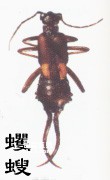Insects of this order are not closely related to humans. A few species harm flowers, stored grains, stored fruits, silkworms and fresh insect specimens. Some species are ectoparasites of bats and mice. Leatheroptera generally like to be active at night and often hide under soil, rocks, dead branches, and garbage during the day. The glandular folds on the 3rd and 4th segments of the earwig's abdomen can secrete a special odor to repel enemies. The tail is a powerful weapon for defense. When frightened, it often raises its abdomen and spreads its tail to show fear. When encountering a strong enemy, it often pretends to be dead. Females have special habits of protecting eggs and raising young.

[Identification points] Body length 4-35 mm. The body is long and narrow, slightly flat. The head is flat and wide, the antennae are filamentous, there is no single eye, and the mouthparts are chewing. The pronotum is well developed, square or rectangular. The body surface is leathery and shiny. Winged or wingless. If there are wings, the forewings are specialized into very small leathery wings; the hind wings are large, membranous, fan-shaped or slightly rounded, folded vertically and horizontally under the forewings when resting, but often exposed outside the forewings. The tail is shaped like a hairpin. No ovipositor. (imitated from Yanfentu)
[Species and Distribution] There are nearly 2,000 known species in the world, which are abundant in the tropics and subtropics. The number of species decreases from the temperate zone to the cold zone, but they are also found in high mountains with an altitude of 5,000 meters in the Himalayas. Currently, 211 species have been recorded in my country.
The characteristics of this order can be summarized as follows: the forewings are short and leathery, the hind wings are like fan veins and bones; the tail is hard and clipped, and earwigs protect eggs like chickens hatching.
animal tags: Insects Dermoptera Earwigs
We created this article in conjunction with AI technology, then made sure it was fact-checked and edited by a Animals Top editor.